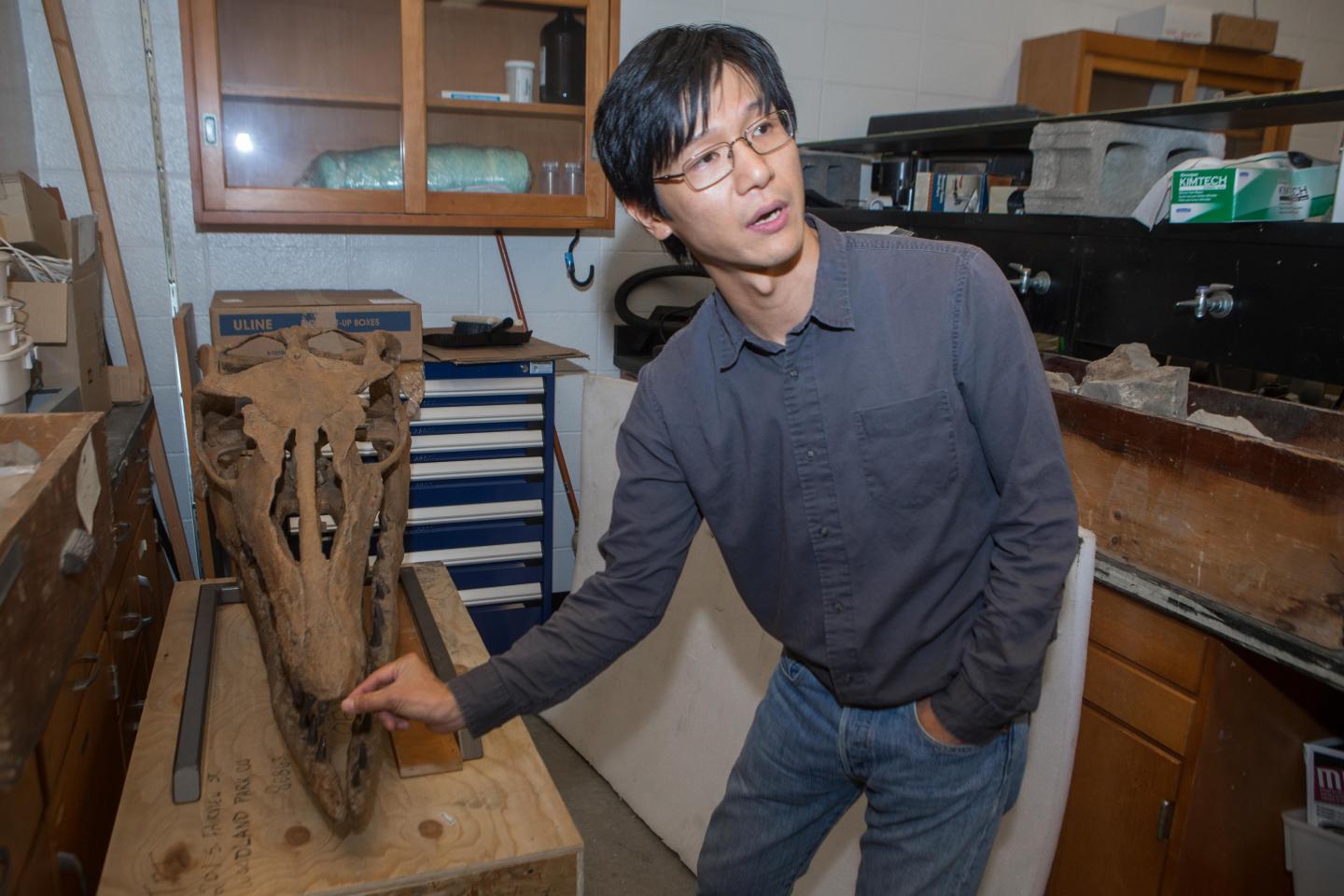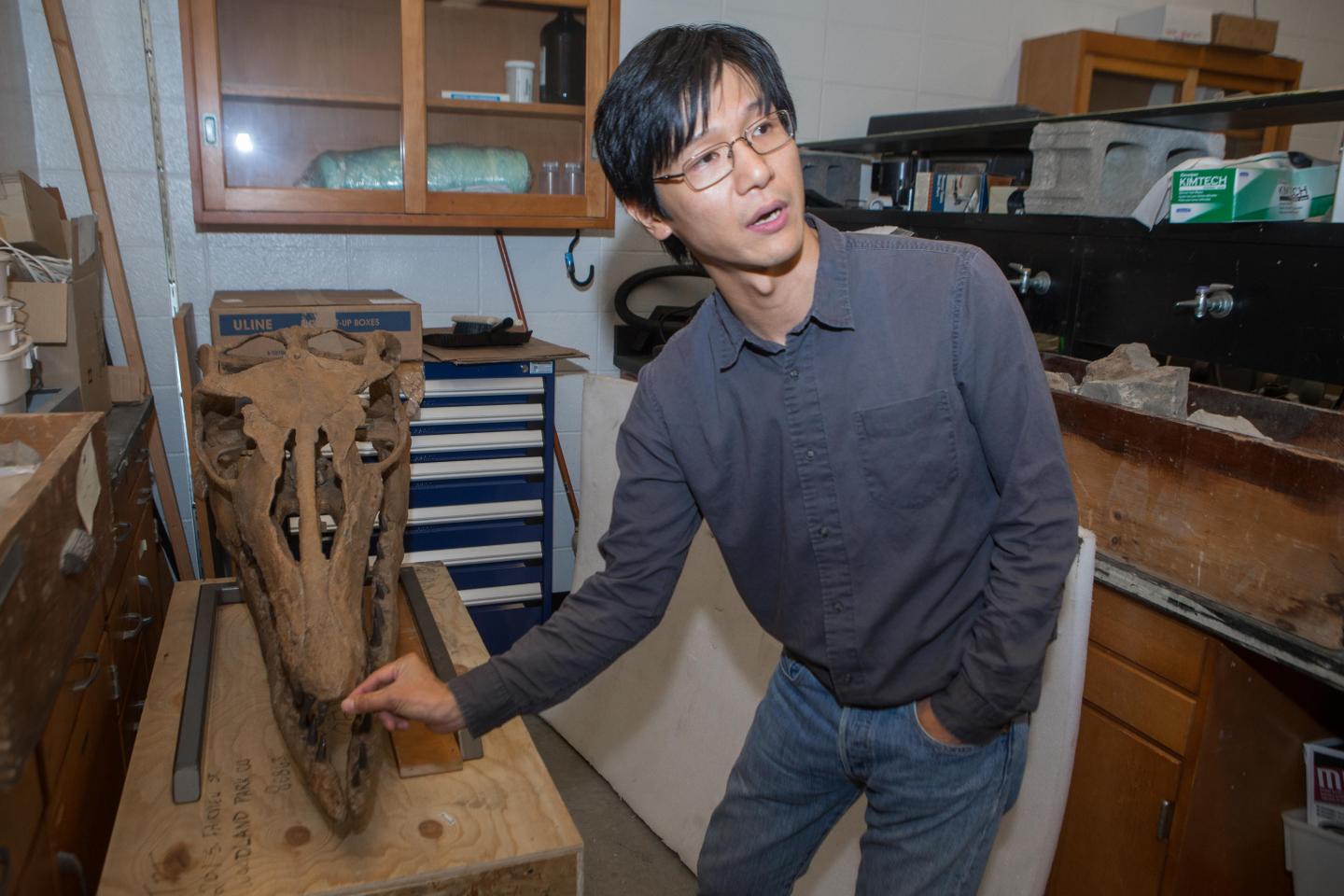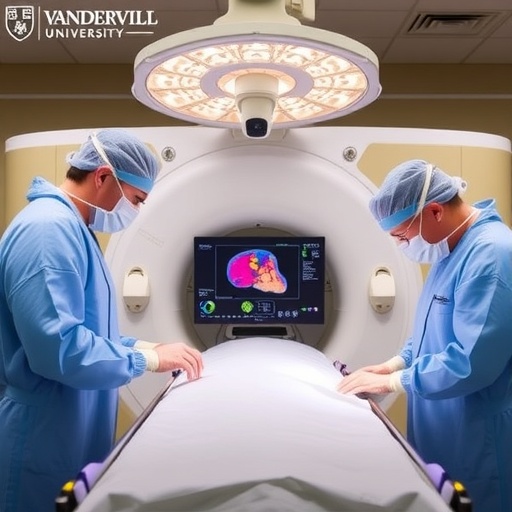
Credit: Joseph Fuqua II/UC Creative Services
Did prehistoric sea creatures called mosasaurs subdue prey by ramming them with their bony snouts like killer whales do today?
It's a theory that University of Cincinnati biology professor Takuya Konishi proposed after taking a closer look at a newborn fossil specimen for his latest research study. Konishi will present his findings at October's Society of Vertebrate Paleontology conference in Albuquerque, New Mexico.
"Killer whales don't hunt big prey by biting. They hunt by ramming and tearing them apart after the prey is weak," Konishi said. "They are chasing fast-moving animals so they use inertia. If they were swimming full speed at you, they would generate a lot of force. And their snout is conspicuously protruding."
Mosasaur, the unlikely hero of the movie "Jurassic World," was an enormous marine reptile that lived in the time of Tyrannosaurus rex during the Cretaceous Period more than 65 million years ago. They had a similar body shape as today's orcas, with flippers, powerful tails and sharp teeth. Some grew bigger than orcas to nearly the size of a school bus.
Like orcas, they were the apex predators of the seas. The only thing mosasaurs had to fear were bigger mosasaurs.
In a study published this month in the Journal of Vertebrate Paleontology, Konishi re-examined fossils of a newborn mosasaur he first studied in Kansas while working on his master's degree in 2004. About 20 small fragments of skull were unearthed in 1991 by paleontologist Michael Everhart in a rock formation called the Kansas Chalk renowned for marine fossils.
Initially, the specimen was identified as a mosasaur called Platecarpus, a species commonly found in that area during the same period 85 million years ago. The family Mosasauridae features more than 30 genera of species, so identifying a particular specimen from a handful of fossil fragments can be daunting.
"A colleague of mine told me mosasaurs are boring because they all look the same. That's sort of true," he said. "But once you know more about them you can begin to tell them apart."
Some mosasaurs had short, powerful jaws capable of crushing the shells of sea turtles. Others had pointy teeth that suggested they feed mostly on fish.
Konishi was inspired to take a second look after a fellow researcher demonstrated how particular bones called quadrates were not as reliable in identifying species as researchers once thought. The telltale fossils of adults of different species look very similar in juveniles.
In the many years since Konishi first examined the baby mosasaur, he has become an expert on these seagoing lizards, including the largest of them called Tylosaurus. This was the creature that inspired "Jurassic World," a meat-eating monster capable of hunting other mosasaurs and marine reptiles.
In re-examining the skull fragments from the newborn mosasaur, Konishi found it did not resemble other specimens of Platecarpus. While Platecarpus and other mosasaurs have teeth that begin virtually at the tip of their snouts, Tylosaurus has a bony protrusion called a rostrum that extends out from its face like an orca that might have served to protect its front teeth when they slammed into prey.
"It's a subtle feature perhaps by horned dinosaur standards, but for us it really signifies what kind of mosasaur you're looking at," Konishi said. "If you have this protruding snout in this part of western Kansas, you're a Tylosaurus."
Like many other kinds of baby animals today, the baby mosasaur had not yet developed certain telltale features found in adults, Konishi said.
"The degree of snout development was nowhere near that of an adult, which made me look elsewhere such as the braincase to call it Tylosaurus in the end. It was the ugly duckling that hadn't yet become the graceful swan," Konishi said.
Unlike other mosasaur species, Konishi said the tylosaur had broader and more robust facial bones connected to a sturdy cranial vault that would have provided support as a battering ram.
Konishi pulled up a dramatic photo showing a breaching orca pummeling a large dolphin with its snout. The dolphin, a species called a false killer whale, was struck so hard that its body was contorted at a painful-looking angle.
"When orcas hunt dolphins and small whales, they subdue them by ramming them. And when you look at them, you see they have a protruding snout as well," Konishi said.
The fossils represent the youngest and smallest specimen of Tylosaurus ever found. Everhart confirmed to Konishi that the baby mosasaur was found alone with no associated fossils. Mosasaurs didn't lay eggs but gave birth to live young. That suggests the specimen was a free-swimming newborn rather than an embryo when it died, he said.
Just how the baby mosasaur perished is a matter of speculation. Only its skull was found. Konishi said the mosasaur could have succumbed to countless mishaps from predation to accident to disease.
It took a miracle of improbability that the baby mosasaur was found in the first place, he said.
Finding any baby dinosaur, or marine reptile in this case, is extremely rare for the simple reason that baby animals often end up as someone else's dinner. The bones of baby animals are lighter and more likely to scatter. But in this case, bones that weren't chewed up reached the ocean floor where they were covered in sediment and remained for millions of years until the seas receded and the former ocean floor became the wheat fields and farmlands of today's Kansas.
"And luckily an expert on mosasaurs was searching in exactly that spot and had sharp enough eyes to find it — all separated by about 85 million years," Konishi said.
"Most fossils are fragmentary. You almost never find an entirely articulated fossil in the ground. That's near fantasy," Konishi said. "Luckily, the remaining bones were buried and became fossilized."
Konishi's theory strikes a chord with orca experts such as Ken Balcomb, senior scientist with the nonprofit Center for Whale Research outside Seattle, Washington. Balcomb has been studying orcas for 43 years. He has seen firsthand the myriad clever methods they employ to hunt different prey.
"They pummel their prey quite a bit. They will throw their body against a gray whale. They'll ram great white sharks, too," Balcomb said.
But Balcomb said they're choosy about what and how they attack, often using their flukes or whole body rather than their heads. They even distinguish between different types of prey.
"They know which kinds of seals will fight back," Balcomb said. "So they're cautious. They don't want to get hurt."
Contributing to Konishi's study were Paulina Jiménez-Huidobro and Michael Caldwell, both of the University of Alberta. The study was funded in part by the Natural Sciences and Engineering Research Council of Canada.
Konishi said this better understanding of the development of baby mosasaurs could help scientists learn more about fossils of other baby dinosaurs and marine reptiles that look markedly different from their parents.
"We now have a bit better insight into how this trademark feature evolved in this lineage," he said. "It's a good starting point for more studies in the future."
###
Media Contact
Michael Miller
[email protected]
513-556-6757
@UofCincy
http://www.uc.edu/news
Original Source
https://www.uc.edu/news/articles/2018/10/n203409.html http://dx.doi.org/10.1080/02724634.2018.1510835






